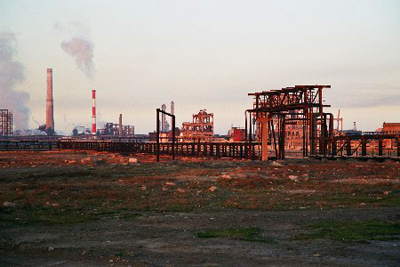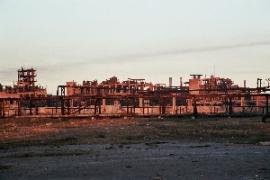Sumgayit, Azerbaijan
- Potentially Affected People: 275,000
- Type of Pollutants: Organic chemicals, oil, heavy metals including mercury.
- Source of Pollution: Petrochemical and Industrial Complexes
The Problem
Sumgayit was a major Soviet industrial center housing more than 40 factories manufacturing industrial and agricultural chemicals. These included synthetic rubber, chlorine, aluminium, detergents, and pesticides. While the factories remained fully operational, 70-120,000 tons of harmful emissions were released into the air annually. With the emphasis placed on maximum, low-cost production at the expense of environmental and occupational health and safety, industry has left the city heavily contaminated. Factory workers and residents of the city have been exposed to a combination of high-level occupational and environmental pollution problems for several decades.
Untreated sewage and mercury-contaminated sludge (from chlor-alkali industries) continue to be dumped haphazardly. A continuing lack of pollution controls, dated technologies and the improper disposal and treatment of accumulated industrial waste are just some of the issues that plague the city.
Health Impacts
Sumgayit had one of the highest morbidity rates during the Soviet Era and the legacy of illness and death persist. A study jointly conducted by the UNDP, WHO, Azerbaijan Republic Ministry of Health and the University of Alberta demonstrated that residents of Sumgayit experience intensely high levels of both cancer morbidity and mortality. Cancer rates in Sumgayit are 22-51% higher than average incidence rates in the rest of Azerbaijan. Mortality rates from cancer are 8% higher. Evidence suggests that lower reported cancer rates are flawed as a result of underreporting.
A high percentage of babies are born premature, stillborn, and with genetic defects like downs syndrome, anencephaly, spina bifida, hydrocephalus, bone disease, and mutations such as club feet, cleft palate, and additional digits.
Status of Clean-Up Activity
The government of Azerbaijan has obtained international support for the economic and environmental rehabilitation of the city from several United Nations organizations, including the United Nations Development Programme (UNDP) and the World Health Organization (WHO). The UNDP helped to create the Sumgayit Centre for Environmental Rehabilitation (SCER) to research and prioritize the environmental problems and propose programs to address them. A number of environmental epidemiology courses were held in Baku to strengthen the capacity of local experts.
In 2003, the World Bank launched a US $2.7 million project for the cleanup of a chlorine producing plant where 1,566 tons of mercury were spilled, including the construction of a secure landfill. Other international projects funded by UK and Japan have also been implemented.
Reports indicate that only 20% of Soviet Era polluting factories are still operating and there are ongoing debates about closure of the remaining number. However, even if all the polluting industries are dealt with, there remains a significant legacy clean-up challenge.
Resources
J.E. Andruchow, C.L. Soskolne, F. Racioppi, et al. "Cancer Incidence and Mortality in the Industrial City of Sumgayit, Azerbaijan". Int J. Occupational Environmental Health. (2006). 12 (3). 234-241.
J. W. Bickham, C. W. Matson, A. Islamzadeh, et al. "Editorial: The unknown environmental tragedy in Sumgayit, Azerbaijan" Ecotoxicology, (2003). 12, 505-508.
"The State of environment. Azebaijan." Ministry of Ecology and Natural Resources of the Republic of Azerbaijan.
Andruchow, James Edward. Epidemiology Program, Department of Public Health Sciences, University of Alberta, January, 2003.
Islamzade, Arif. Sumgayit: Soviet's Pride, Azerbaijan's Hell. Autumn 1994.
Additional Photos
 |
Currently polluting factories in Sumgayit are using dated technologies and improperly disposing and treating industrial waste. Photo Credit: Adam Klaus / Blacksmith Institute |
 |
Cancer rates in Sumgayit are 22-51% higher than the national average in Azerbaijan. Photo Credit: Adam Klaus / Blacksmith Institute |




